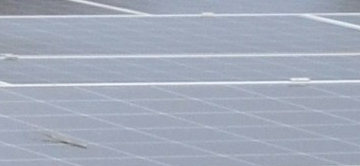France receives about 14% of its electric power from hydroelectric plants whose outputs vary greatly depending on seasonal precipitation levels. Although there are major differences between countries, on average the percentage is the same in the European Union and the rest of the world. But the significance of this technology extends beyond its production levels. In fact, the flexibility of hydroelectric power plants makes this form of energy a crucial part of the answer to the versatility of intermittent demand and energy sources. Furthermore, after water circulates through turbines to generate electricity it can be put to other good uses downstream of retaining structures. So, in order to gain the most benefit from water resources, there must be an institutional framework whereby operators can take advantage of their equipment's flexible nature as well as meet the needs of other users of water. Currently, in France private operators are running large reservoirs through a concessionary scheme and the government is looking to replace these operators with semi-public companies. Can we expect to see more collective efficacy?
Water, water, everywhere!
Right now in France, hydroelectric resources are the second largest source of electricity, after renewable energies.[1] At the end of 2012, around 2,250 units of vastly different sizes accounted for 25 GW of installed power, or 20% of total production capacity in mainland France. EDF manages 80% of hydroelectric power. The other leading operators are Compagnie Nationale du Rhône and Société Hydro-Electrique du Midi.
Nearly half of the production comes from so-called run-of-river plants, which are production units whose primary energy is kinetic energy generated by flowing water. Production is fully dependent on the water flow rate. Just like wind for wind mills, water that is not used to generate power is lost. Except for maintenance sessions, these plants operate non-stop.
Pondage stations and storage hydroelectric plants cover around 20% of production each. The former can store water for a matter of hours or days, while the latter can do so for months or even years on end.
Finally, about 10% of production is generated by pumped-storage hydroelectricity stations (PSH), which are plants that can consume electricity to pump water from a lower elevation reservoir to a higher elevation storage unit during low-cost periods and then released through turbines to feed the electricity generated into the grid at periods of peak demand.
In addition to relying on a free supply source (with the exception of PSHs), the best thing about hydraulic storage plants is their extremely high capacity to meet demand. Electricity is produced just a few minutes after the water is released into the turbines. This means it is a technology that can keep up with rapid changes in need, especially in Winter in our part of the world, and sporadic injections of electricity from wind and solar sources.
How should dams be managed?
For nearly a century (since France's Act of 16 October 1919 regulating the use of hydraulic power), major hydroelectric plants (over 4500 kW) have been operated through a concession-based scheme in France. Concessionaires build the structures, which remain government property, and can operate them for up to 75 years, constrained by a set of specifications. When this contract is up, Article 13 of the regulation gives preference to the original concessionaire as long as it agrees to the new specifications. But with competition opening up in the electricity production sectors, the European Commission has asked French authorities to do away with this right of preference.[2] It was repealed in 2006 when the law on water and aquatic environments was passed. So how can we now award operating rights for hydroelectric dams when the contracts come to an end?
As 2015 begins, the state of hydroelectric plants hangs in the balance as talks continue in the French Senate about the "draft bill on the energy transition for green growth" after being passed by the National Assembly on 14 October 2014.[3] Article 29 of this document plans to entrust concessions operations to semi-public hydroelectric companies, in this case government-owned public limited companies with at least one private individual, plus potentially other public entities. Legislators hope this package will ensure management in line with the collective interest while taking advantage of the expertise of private companies. It should be said that water is a rather unique economic commodity.
Water is a private good, water is a public good
There are multiple uses for water resources stored in a dam that on the whole are not conflictual. After water has been injected into turbines to produce electricity, it is still available downstream for many other uses like irrigating farmland and providing drinking water to people living in the valley. But the complementary nature of water that makes it a public good begins to fade when we consider its periods of availability. In effect, the exploitation of water for most uses depends on when it is available and the state of nature at that time. For example, water is more valuable for farmers in summer than in winter, but in our geographic location it is the reverse for hydroelectric operators. Similarly, the times of year and environmental conditions conducive to water maintaining the low water mark and supporting biodiversity do not always coincide with the times and conditions when water is needed to cool thermal plants or when flows need to be regulated to prevent spates.
These competing times and converging interests in the resource is what makes it compelling to assess hydraulic resources, and more specifically the stores of water being managed by electricity producers.[4]
If the various users of water have a high demand at the same time, the "public good" aspect outweighs the "private good" aspect. Users do agree on the dates for releasing more water and the steward of the resource faces a billing problem to the extent that it cannot reckon each type of user's willingness to pay. Conversely, if the consumption values are negatively correlated, competition between the various types of water users has more to do with the date of delivery, whereby the "private good" takes precedence because users are competing for the availability of a given quantity of water.
This private good/public good duality makes it tricky to organise the management of water reservoirs efficiently. The market is the best tool for regulating the private dimension, thereby allocating out reserves at different times. On the other hand, the public good aspect opens the door to a free-riding behaviour. This requires government intervention, either directly through grants or usage fees, or indirectly by allocating tradable rights – or a combination of both approaches.
Institutional framework
Considering the pivotal role that hydroelectric plants play in the electric power supply system and the wide range of uses for water, the economic stakes of a strong institutional foundation are high.
The concession solution gradually became law in response to the burgeoning electricity industry at the turn of the 20th century. Public authorities saw an efficient solution in handing over the management of the resource to electric companies in exchange for licence fees because, from a technical perspective, they were the most upstream users. By imposing on them a list of specifications and a water regulation, the public authority was also ensuring that the needs of other users were being met. Payment may or may not be received for the flow constraints these requirements generate. When they are remunerated, it is through an administered pricing system, not by trading on the market.
In 2010, French authorities considered a competitive bidding process to renew concession contracts that had expired. In addition to French operators, European companies like E.ON, ENEL, Iberdrola and Vattenfall showed interest and opened offices in France. But in 2012, the elected majority (and four consecutive energy ministers) brought in plans for a new statute and several European operators closed their Paris offices.
Semi-public hydroelectric companies
As written in the "draft bill on energy transition for green growth" being hammered out in the French Senate as of early 2015, the hydroelectric concession statute is a new feature. The "semi-public hydroelectric companies" stipulated in the text essentially do not exist yet. We cannot even gain any insight from the Single-Operation Semipublic Companies[5] because they are extremely new and have a local scope (Law No. 2014-744 of 1 July 2014). So we actually do not have any hindsight on which to base any tangible advantages and disadvantages and, for the time being, we only have a few general views to go on.
Semi-public companies are usually formed to give public corporate entities an absolute majority of share capital while keeping a blocking minority for the private operator. That said, the draft bill contains no requirement on public majority ownership: "The government, and, where applicable, regional authorities (…) and public partners (…) jointly own a minimum stake of 34% in the company and a minimum of 34% of the voting rights in the legislating bodies. The operator shareholder may not hold less than 34% of the capital share and voting rights."
These percentages afford wide latitude that creates expectations of intense negotiations before a semipublic company is even formed. But the draft bill contains plans for a two-step process to start these companies: "Prior to selecting the operator shareholder, an agreement shall be reached on the methods by which the government, regional authorities or their consortia and public partners associate within a semipublic hydroelectric company, (…)." In other words, first the public part (central government and local authorities) sets the rules of the game and then tackle finding a private partner through the bidding process. One could hardly imagine that the public part, which barely understands the technical and economic issues involved in managing reservoirs, are not trying to fine-tune the future partnership agreement by negotiating with private operators from day one. If negotiations take place, there is a risk they will be secret and therefore dubious. If negotiations are not held, the system will run into problems of adverse selection, meaning theoretically private applicants will not put up much of a fight because their main concern will be to conform to the image of a minority shareholder. It must be stressed that within this legal framework, competition is reduced to choosing the economic operator.
A last point worth mentioning is the ambiguous role that public authorities play in this political-commercial arrangement. The French government and partnering public entities will be collecting both water usage fees[6] and dividends on the semipublic company's profits. The regulatory provision for this hybrid outfit remains to be written.
*
* *
The unique nature of water is behind the current legislative fumbling; since the dawn of time, regulations on the control and distribution of water have been more or less non-confrontational. It may seem that establishing joint management between the central government, regional governments and private companies will only make it more complicated to build and manage dams. But this arrangement is substantiated by water's special economic properties in that it changes its location, state or quality, but is never destroyed. So we must keep in mind the duality of water, a commodity that is both private (it cannot be consumed by many different types of users at the same time) and public (it is not destroyed by consumption). Therefore, the value of water stored in a dam is neither just its biggest utility value (e.g. the value created by an electric company or a farming collective) nor just the sum of its utility values–it is both at the same time. Combining these attributes bestows a special economic feature upon the water resource that we see in the multi-criteria bidding for concession contracts advocated by the previous majority. We also see it in the present-day legislative approaches being steered toward semipublic companies. Economists are concerned because of the potential to see an institutional solution passed that is motivated by the federal government's fiscal interests and local stakeholders' voter pandering, rather than a concern for collective efficacy in water management.
This article is also featured on the Florence School of Regulation blog
[1] Source: The 2013 survey of electric renewable energy in France. Observ’ER, fourth edition
[2] Article 38 in the Sapin Act of 1993 clearly stipulates that public service contracts for government agencies must be subjected to competitive tendering in a bidding process. But Article 41 declares the bidding requirement no longer applies when the law institutes a monopoly for one company or when the public service is handed over to a public institution. EDF lost its monopoly in 2000 and then became a public limited company in 2004.
[4] For a formal analysis in French, see C. Crampes and M. Moreaux (2015) "Microéconomie de l’hydroélectricité. Partie 1. Valeurs de l’eau, IDEI Report, No. 26, January, http://idei.fr/doc/rap/valeur_eau_janv_2015.pdf
[5] The main characteristics of Institutionalised Public-Private Partnerships upon which the Single-Operation Semipublic Companies are based were stipulated by the European Commission in an Interpretive Communication on 5 February 2008 (C(2007) 6661) and confirmed by the Court of Justice of the European Union on 15 October 2009. For further clarifications (in French) about Institutionalised PPPs, see L. Rapp (2010) "Quasi régie, quasi régime", L’actualité juridique-Droit administratif (AJDA) p.588-595.
[6] Article 33 of the Law of 30 December 2006. However, we note that this fee is not charged yet, due to the delay caused by the concession renewal process. In its summary judgement on 21 June 2013, France's controller and auditor general alerted the ministers in charge to the government's budget shortfall of €320 million, which was not collected for 2012.





